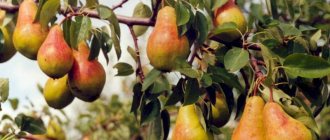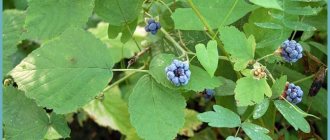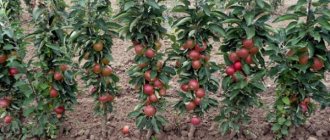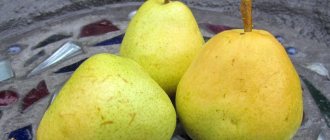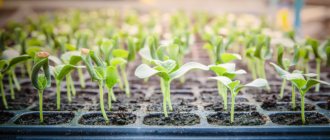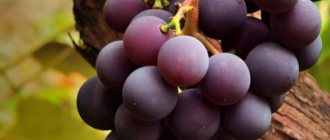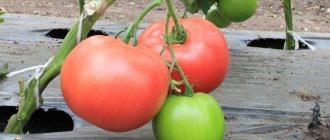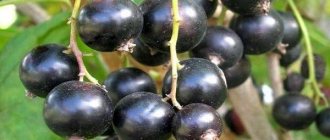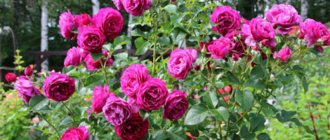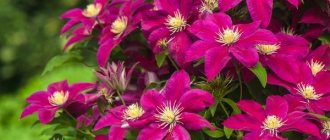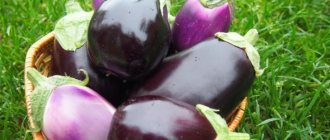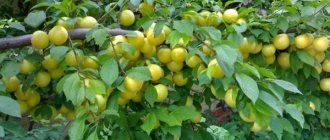Low-growing self-fertile plums
Low-growing self-fertile plums
Low-growing plums take up less space on the site than simple, tall ones. Another advantage is that they are easy to harvest. But there are not many such plums, especially if the tree must also be self-fertile.
- The “early fruiting” plum comes from China. It grows up to 2.5 meters, the crown is rounded and not dense. The leaves are light green in color, small, glossy. Flowering very early. The fruits weigh 30 g on average. The peel is dense, tasteless, orange to red in color. The pulp is yellow, with a high juice content, not very dense, but when preserved in pieces it does not fall apart. The taste is a bit like melon, sweet with a slight sourness.
- "Red Ball" is a variety obtained in China. This tree is very compact, small in size, growing up to 2.5 meters maximum, but usually less. The crown consists of spreading branches that require regular pruning. Leaves appear after flowering. The first flowers appear on the tree in early spring. They are snow-white and small in size. The fruits weigh on average 35-40 g. The peel is red, dense, but thin, with a bluish coating. The pulp is juicy and light. The drupe does not separate well from the pulp, so it is not very suitable for processing.
“Orlovskaya Dream” is a variety created on the basis of the Annushka plum. The tree grows up to 2.5 meters in height. The crown is not very thick, spreading, and needs shaping. Flowering is observed from May, and fruiting from the first days of August. Plums 40 g on average. The peel is red with a coating. The pulp is juicy, sweet, yellow. The main advantages include winter hardiness and productivity.
Early-fruiting plum varieties are in great demand among gardeners. It is profitable to plant them in small areas, for personal use, and not for sale. They don't produce much harvest, but enough for home canning. The main thing is to choose the right variety so that the tree brings maximum benefits and does not require heavy care.
Late-ripening cherry plum
Late-ripening varieties ripen in September. Ideal for winter preparations.
Gift to Primorye
The height of the tree is 3-4 m, the crown is medium dense, wide-pyramidal in shape. The fruits ripen in early September. Suitable for cultivation in Siberia and the Far East. Immunity to diseases is high. Requires pollinators.
The fruits are large, weighing up to 35 g. The shape is oval-elongated. Color – purple. The pulp is sweet and sour, reddish in color, fibrous. The variety tolerates harsh winters well and does not like dampness. Harvesting cherry plum - up to 30 kg. When overloaded, the branches break.
Mara
A variety bred from cherry plum and Chinese plum. Late-ripening cherry plum is frost-resistant (down to minus 38°C) and has high immunity. The variety is often called “Russian plum”. The first harvest is for 2-3 years. A tree lives up to 50 years.
Fruits with a dessert taste and loose pulp, sweet (contain up to 10% sugars). Color – yellow-orange. The shape is round, slightly flattened. There are notes of grapes in the taste. Separating the seeds is problematic. Weight - up to 23 g. It has a long shelf life - at normal temperatures it is stored for 15-20 days. Every year the tree produces up to 25 kg of cherry plum.
Advice from experienced gardeners (agricultural technology)
In central Russia, the success of growing this crop very seriously depends on what conditions are created in a particular area. So, in order for the tree to winter better, it is recommended to plant it on slopes on the southern or southwestern sides, on higher elevations of the terrain. The favorable proximity to large industrial cities located to the north also has a good effect on the cultivation of cherries. Few people take into account that the warming effect of such cities can extend over tens of kilometers. It is this difference of 5-8 degrees that can have a very significant effect on the condition of cherries in winter at the minimum winter temperature.
Proper cherry farming technology allows you to obtain stable and high fruit yields.
How to determine if a site is suitable for growing a southern tree? You need to assess the condition of your neighbors’ garden: if your neighbors grow cherries and don’t freeze, then it is possible to grow cherries.
On a note! The bulk of varieties of Central Russian cherries are self-sterile, that is, they are not able to self-pollinate their flowers. At the same time, in comparison with the same cherries, they are pollinated by bees much better, and therefore they delight us with a harvest under good conditions.
Nevertheless, among the northern varieties there are also self-pollinating ones: Iput and Ovstuzhenka. Both varieties are self-fertile. Even if the variety is self-fertile, its yield increases significantly if trees of other pollinating varieties are placed nearby. For example, the pollinator Revna provides a good neighborhood.
The Ovstuzhenka variety is a real find for northern gardeners. It can be grown in risky farming zones and even in some areas of the Far North. It, as well as some of the varieties listed above, can survive frosts down to 35 degrees, and Ovstuzhenka will even overwinter at temperatures down to minus 45 degrees. But it is considered half self-fertile, and therefore it is better to plant a pollinator nearby, otherwise only ten percent of the fruits will receive an ovary, which is not much.
What else can be recommended to those who are starting to grow cherries in northern conditions for the first time? Here are some tips and tricks:
In order for plants to be better pollinated, it is advisable to have at least three varieties in the garden; when planting in northern conditions, you need to take into account that cherries do not like swampy soil under the roots, but, on the contrary, they welcome sunny areas; cherry, being a fairly tall plant, will create a large shadow, which is also important when planning a summer cottage or garden plot; You should not plant varieties that are susceptible to the same disease. There are varieties that are highly resistant to certain diseases, and if you purchase seedlings that are susceptible to diseases, let them be adjacent to those that are not afraid of viruses; Cherries should be fed two to three times a year. And although it bears fruit every year even without it, fertilizing will not hurt
Fertilizing before winter, with fertilizing in the fall, will help the tree cope with the winter cold
And although it bears fruit every year even without it, feeding it won’t hurt. Fertilizing before winter, with fertilizing in the fall, will help the tree cope with the winter cold.
As is clear from the article, growing a southern cherry tree in the north is quite possible, although it requires some conditions and skills on the part of the garden owner. For everything to work out, you need to make the right choice of variety from the very beginning.
Adding an article to a new collection
Don’t know what type of cherry to plant on your plot so that ripe and juicy berries ripen on it every year? This article will help you navigate the variety of varieties.
When choosing productive varieties of cherries for the middle zone, you first need to pay attention to such an important property as winter hardiness. Do not forget that until recently, cherries were exclusively a southern crop. Only thanks to the hard work of breeders, it was possible to create tree varieties that annually produce harvests in regions with very harsh winters
Only thanks to the hard work of breeders, it was possible to create tree varieties that annually produce harvests in regions with very harsh winters
Only thanks to the hard work of breeders, it was possible to create tree varieties that produce annual harvests in regions with very harsh winters.
For such an area, try to select varieties that bloom later, when the threat of return frosts is minimal, or those varieties whose flowers are resistant to negative temperatures in the spring
This is very important for obtaining stable cherry harvests in the middle zone. Of course, it is difficult to get such a quantity of ripe berries as in the south (up to 100 or more kg per tree) in the middle zone, but collecting 45-50 kg is quite possible
The most frost-resistant cherry plum varieties for the central and middle zones
To grow cherry plum in Central Russia, you need to pay close attention to the frost resistance of the variety. Trees must not only survive winter cold well, but also spring frosts, because the main threat from an unstable climate lies precisely in them. The following varieties have the best performance : Tsarskaya, Seyanets Rakety, Vladimirskaya Comet and others.
Gift to St. Petersburg
Cherry plum Gift to St. Petersburg
The variety is distinguished by good resistance not only to cold weather, but to unstable climatic conditions, heavy rainfall and frost. A medium-sized tree with a wide, dense crown of large sizes, bears its first fruits already in the 4th year of life. Productivity is annual. The fruits are light orange in color, slightly elongated in shape and weigh only 20 grams . The taste is sweet and sour; the fruits also tolerate transportation well and can be used for various types of preservation.
Vladimir comet
Cherry plum Vladimir comet
This variety was bred relatively recently, but in all respects it already surpasses many old subspecies. A medium-sized tree has a wide but at the same time sparse crown. The fruits are large in size, round-oval in shape with a pointed end, burgundy skin color, with a light waxy coating . The pulp is a rich, dark orange color with a sweet and sour taste. The purpose of such cherry plum is universal. The tree quickly begins to bear fruit and also quickly increases its yield; ripe cherry plum can be harvested as early as mid-July. Frost resistance is very high, the same applies to the self-fertility of the variety.
Rocket Seedling
Cherry plum Rocket Seedling
The variety is distinguished by exceptional frost resistance; a medium-sized tree can withstand frosts down to -35 degrees. The crown of the tree is dense and spreading. The fruits are large, grow up to 30 grams, red in color, round in shape with pointed ends . The productivity of the variety is at the highest level.
Timiryazevskaya
Cherry plum Timiryazevskaya
The variety got its name in honor of the scientific institute where it was bred. The tree grows to a height of no more than 3 meters, the crown is spreading, its shape resembles a cone, the foliage is very sparse. The fruits are small, egg-shaped, covered with a thin skin of light red color. The pulp is very tasty and juicy, loose, fibrous, the stone is separated without difficulty. From one tree you can collect up to 30 kilograms of fruit , while it does not require complex care, tolerates frost well and is not affected by fungal diseases.
Features of cultivation in the region
It is not recommended to plant self-fertile and early-fertile varieties of this plant crop in holes that are too deep. Otherwise, the trees will die soon after planting. From their own gravity they will settle, and rainwater will stagnate. If the roots are placed too deep, the bark will rot in the lower part of the trunks.
Vladimirsky and any other variety of red or yellow cherry plum, even self-pollinating varieties, should be planted in areas that are not exposed to too much sun. This plant does not tolerate direct sunlight well. When planting, it is recommended to use growth stimulants.
Experts advise planting the best self-fertile cherry plum varieties for the Moscow region in the spring, as soon as the snow melts. Taking into account the spreading nature of the crown, plant plants at a distance of 3 to 6 m from each other. Any soil will do, but as it grows, you will have to carry out preventive work to combat both types of borer and plum moth.
You should not buy the largest seedlings for planting. This is one of the most common mistakes. If the seedling is too large, it is recommended to remove almost the entire crown. An underdeveloped crown of small seedlings is the key to successful cultivation and a good harvest.
Columnar varieties for the Moscow region need to be grown carefully, since if there is a lack of fertilizers during the growth process, the tree can produce an early harvest. This can happen as early as a year after planting. But an early harvest for these plants is not a good sign. The fact is that this phenomenon greatly depletes the tree. Subsequently, it will not be possible to obtain a large amount of ripe cherry plum.
And in small, ugly seedlings, the crown is not yet developed or is completely absent, but their roots are much less damaged when dug up. Such seedlings take root much faster and in the future will outstrip three-year-old seedlings in growth. You should not buy seedlings at spontaneous markets or from cars entering gardening areas, or standing along the road. Buy seedlings exclusively zoned and only in the nursery, that is, those that are zoned specifically for your climate.
Pests of cherry plum
Like all fruit trees, cherry plum has its own diseases and pests. This garden plant is slightly susceptible to various diseases, but can become infected from neighbors in the garden.
Pears for the Moscow region: the best varieties
Main harmful insects:
- sawflies;
- apple scale insects;
- copper or black borers;
- plum moths.
In order to protect your garden from their influence, you need to treat it with special products such as Iskra, Fitoverm, Akarin. Their use is allowed no more than once a month during the season.
Important! When treating with special means, it is necessary to spray not only the cherry plum itself, but also neighboring fruit trees.
In early spring, it is worth spraying the garden with a urea solution prepared at the rate of 700 g per 10 liters of water. Bordeaux mixture or another preparation containing copper is also suitable. To avoid burns on the leaves, treatment is carried out before the buds begin to bloom. This will protect the cherry plum and other plants in the garden from being damaged by fungus and other diseases.
Diseases such as milky sheen and clasterosporiasis are common. They occur before the fruit appears. During the fruiting period itself, cherry plum is affected by monoliosis, or gray rot. If cherry plums hang close to each other, the disease spreads quickly.
They fight diseases by removing diseased parts of the tree, and for prevention they use means such as Bordeaux mixture and timely pruning.
Trimming
Cherry plum propagation rules
Now you know what cherry plum is, planting and caring for it in the middle zone has some nuances.
In particular, this applies to tree propagation. It is performed by grafting, seed and layering. The most popular method of propagating columnar cherry plum is grafting. But this method has one significant drawback - grafted plants lose frost resistance and can freeze in winter. To do this, an incision is made on the trunk or large branch and the grafted shoot is tied to it.
Cuttings of columnar cherry plum have also proven themselves to be excellent. To do this, take a strong cutting in spring or autumn and place it in sandy soil until roots appear. For best results, it is recommended to place the tray with the cuttings in a greenhouse or under film.
Varieties of red-leaved cherry plum
The llama will not only bring a bountiful harvest (40–50 kg per tree), but will also become a decoration of the garden. The fruits have a sweet and sour taste, their weight varies between 30–40 g. A low-growing shrub no more than 2 m in height. Lama's peculiarity is its reddish leaves. Ripe fruits fall off easily in strong winds. It can be grown in the middle zone, the North-West region and Siberia.
Main types
Spreading plum, denoting wild-growing species, and cherry-like plum, uniting cultural forms - all this is cherry plum. It is divided into subspecies, which differ markedly from each other:
- Caucasian cherry plum (typical). These are wild shrubs or trees common in Asia Minor, the Caucasus and the Balkans. The fruits are most often yellow, but sometimes they are also dark in color. Their size is small, from 6 to 8 g. Plants form thickets in the mountains and foothills.
- Eastern cherry plum. Distributed in Afghanistan and Iran. It differs from the Caucasian variety by smaller fruits. The taste is dominated by sourness and slight astringency. The skin color varies, from light yellow to dark purple.
- Large-fruited cherry plum. Unites cultural forms that occupy not the least place in gardens. Conventionally, they can be divided into varieties according to growing regions. Centuries of folk selection have given us the Crimean cherry plum with large sweet and sour fruits and the Georgian cherry plum, which is more sour and tart, from which the famous Tkemali sauce is obtained. Tauride red-leaved (pissarda) is very decorative. This cherry plum is widely used in landscape design; its fruits are also very tasty. There are also Iranian and Armenian.
Brief description of cherry plum
Cherry plum is a species of the plum genus of the Rosaceae family. In the wild it grows as a shrub or multi-stemmed tree. The height of the specimens varies, depending on the type, it can range from 2 to 13 m. The leaves are green, round, with a pointed tip. In spring, the plants are covered with white or pinkish flowers. Cherry plum is an excellent honey plant. The fruit is a fleshy drupe of round, flattened or slightly elongated shape and of various sizes (from 12 to 90 g). Color can vary from light yellow to almost black. Cherry plum is a very fast-growing crop; most varieties produce a harvest already in the 2nd–3rd year. This is reflected in the lifespan of the plant - only 25–35 years.
The fruits are low in calories, about 34 kcal per 100 g. They contain a lot of vitamins and microelements, as well as pectins and organic acids. The low sugar content allows the use of cherry plum in dietary nutrition, including for cardiovascular diseases, since it contains a lot of potassium. The fruits do not cause allergic reactions and can be included in children's diets. In the food industry, cherry plums are used to make juices, jams, pastilles and much more.
What is the reason for its popularity among gardeners?
A botanical culture from the Rosaceae family belongs to the Plumaceae genus. Taxonomists distinguish the following main types of cultivated cherry plum - Caspian, Iranian, Fergana, Syrian. Wild plums include the plum. To date, breeders have developed more than 100 different hybrids of tasty fruits, distinguished by the best qualities - frost resistance, winter hardiness, productivity and excellent taste. The ability to cross species and create new varieties makes the plant attractive to gardeners.
To successfully plant a plant, you must adhere to the agrotechnical recommendations of gardeners:
- The culture takes root anywhere in the garden. The main thing is that groundwater lies about 1 m from the surface.
- The ideal soil is loamy or well-drained. The plant does not adapt well to heavy soils.
- The roots of the tree are located at a depth of up to a meter.
- The right time to plant a plant in southern latitudes is autumn, in middle latitudes it is spring.
- Planting material can be in the form of a seedling with its own root system, a grafted sprout or root shoots.
- Before planting a young tree, a deep, wide hole of 60x60 cm is dug, watered well and fertilized with humus or potash fertilizer.
- A shrub is planted, its roots are carefully straightened and covered with earth.
Once the hybrid plum takes root, it will quickly grow. The length of the branches will reach 2 m and they will need to be shortened to 50 cm, which will ensure increased growth of the tops. The first fruits of the cherry plum will appear three years after planting. At this time, the tree requires regular care, which involves loosening the soil and mulching, and constant watering during drought.
Gardeners with experience in growing cherry plums give the following recommendations to beginners:
- The culture does not tolerate acidic or alkaline soil. The soil should be fertilized with organic matter.
- The tree should not be over-watered - cherry plum is sensitive to excess moisture in the soil.
- You cannot cut the crop too much - this will lead to freezing and burning.
- It is necessary to choose the right seedlings. You should purchase only zoned varieties and only from nurseries.
- Do not plant trees in deep holes with loose soil. After such planting, the cherry plum will grow strongly and sag under its own weight. In addition, precipitation will stagnate, which will lead to rotting of the root system.
So, if you follow all the rules and recommendations, even in the middle zone of Russia, namely in the Moscow region, you can cultivate such a southern crop as cherry plum. The main thing is to wisely choose a variety suitable for this region.
How are cherry plums classified by shade?
Another characteristic by which cherry plum varieties are classified is the color of the fruit. It can vary from yellow to dark purple and almost black.
Yellow cherry plum
Tsarskaya. It bears small yellow fruits weighing up to 20 g. They ripen by the beginning of August and are valued for their excellent taste and portability. Rich in citric acid, contain a lot of sugar. The tree is medium-sized and begins to bear fruit already in the second year after planting.
Oriole. It grows to a height of just over 5 m and bears fruit regularly and abundantly. It is resistant to heat and lack of moisture. Yellow color. Ripens at the end of July.
Cherry plum with red fruits
The July rose bears red, elongated fruits, weighing up to 40 g. The tree is of medium height. It can bear fruit without a pollinator, but with one present it will produce a larger harvest.
Green cherry plum
Unripe cherry plum is used in cooking as part of sauces and side dishes. Green fruits contain large amounts of citric acid. By adding this seasoning to a dish, you can improve both its taste and digestibility.
Cherry plum with purple fruits
Found. Large-fruited variety with early ripening. Fruiting begins already in the 3rd year of life, the weight of the crop can reach 40 kg per year. The fruit is purple in color with yellow flesh, weighing up to 35 g. Resistance to temperature changes is high, resistance to lack of moisture is average. For pollination, other species that bloom around the same time must be planted nearby.
Other varieties of plums that can be grown in the Moscow region
Through the efforts of modern breeders, more than 400 varieties of plums have been developed. We can highlight the most interesting ones, which have also taken root in the Moscow region.
| Characteristic | Varieties |
| Large-fruited | Gigantic (up to 60 g), Angelina (from 60 to 90 g, maximum - 120 g), Volat (up to 70 g), Kazanskaya Krupnoplodnaya (up to 60 g), Blue Free (from 60 to 100 g) |
| Low growing (up to 2.5 m) | Alexy, Oryol dream |
| Medium height (2.5-4 m) | Nika, Okskaya, Malakhovskaya, Bolkhovchanka, Kroman |
| Early | Kabardinka, Starting |
| Late | Hungarian Moscow, Stanley |
| Self-fertile | Violet, Zhiguli |
| Sweet | Opal |
| Particularly winter-hardy | Ksenia, Podgornaya, Sinilga, Ural Dawns, Dashenka, Victoria (Vika), Danae |
| Chinese plum | Beautiful Evening, Souvenir of the East, Testament, In Memory of Putov, Pioneer, Peresvet |
| Japanese plum | Alyonushka, Skoroplodnaya, Shiro, Red Heart, Meihua, Sargenta (ornamental variety) |
| red plum | Red meat, Harmony |
| yellow plum | Ochakovskaya yellow, Svetlana |
| Red-leaved | Hollywood, Cystena |
Gold of the Scythians. You can’t ignore the plum’s closest relative, the cherry plum. This is a fairly new crop for the middle zone. But it has already become widespread due to the fact that frost-resistant varieties have been obtained:
Another interesting variety is Russian plum. In fact, this is a hybrid of cherry plum, which was created through the work of breeders. It was bred by crossing 4 varieties. The fruits are large and sweet, for which it is often called Super cherry plum. Now on sale you can find varieties such as:
This is interesting! Sometimes you can find an exotic fruit in stores - the Kakadu plum. Despite the name, this crop belongs to a completely different family and grows in the tropics. However, Kakadu has many health benefits.
It’s not at all difficult to get a good harvest if you know which plum and how best to plant it in the Moscow region.
The variety of varieties allows every gardener to find the right option for themselves. It is necessary to consider how many plants you plan to grow. For single plantings, it is better to choose self-fertile varieties to avoid problems with pollination. Owners of large gardens can combine different types, focusing on the taste of the fruit.
Plums have a place of honor in the garden. This delicious delicacy is also a very useful product that improves stomach function and normalizes blood pressure. But if there is only enough space on the site for one tree, then you need to choose a self-fertile variety. Self-fertile varieties of plums produce large yields even if there are no pollinating trees nearby. They are capable of self-pollination and this is their main advantage. But there are not many such varieties. This article presents only the best varieties of self-fertile plums of various types.
Large-fruited cherry plum
One of the largest-fruited cherry plum species is General. The weight of the fruit can reach 80 g; they are located separately on the branches. The variety is resistant to frost and is considered early ripening.
Globus is a large-fruited variety, the weight of one piece can reach 100 g. It is a hybrid obtained by crossing the Obilnaya variety, the Kulturnaya Red hybrid and the apricot. If the harvest is abundant, the fruits are smaller in size, but still reach a weight of 50–60 g. The color of the skin is dark blue, the flesh is yellow, and juicy. Due to intensive growth, branches should be pruned regularly.
Cherry plum for the Moscow region - the best varieties
Cherry plum successfully crosses with plum, which has good frost resistance. In this way, cherry plum varieties suitable for the conditions of the Moscow region have been developed, including hybrids.
The culture can be roughly divided into several groups, which are a variety of cherry plum from the southern regions. For cold climate conditions, a hybrid based on Chinese plum was bred, which served as the basis for new frost-resistant varieties. Today this group of varieties is called “Russian plum”. In fact, this is a plum, which has a peculiar sourish taste.
The best varieties of cherry plum for the Moscow region are presented below.
Ruby
Hybrid cherry plum, suitable for growing in the Moscow region. The variety tolerates drought well and is very resistant to frost. Has an average ripening period. It happens that it bears fruit unstably, as it depends on weather conditions.
The tree itself has a spreading, dense crown and medium height. The fruits average 30-35 g, dark red in color. The pulp is juicy, sweet and sour in taste.
Precocious
The variety has good frost resistance and early ripening. The fruits are quite large and red-orange in color.
The trees are small in height, and fruiting is stable and begins in the 3rd year. Precocious cherry plum is a product of Chinese selection. Requires nearby pollinators. The pulp is yellow, pleasant and juicy. Overall, this is a tasty cherry plum variety that is perfect for fresh consumption.
Kuban comet
Perfect for small areas. It tolerates even severe frosts well, but is demanding on moisture. The tree itself is compact in size and has a good yield, reaching 40 kg per tree per season.
The fruits are colored red, but their flesh is yellowish. Weight is within 30 g. The bone is difficult to detach from the pulp. They have a sour taste, are good for processing, but can also be eaten fresh. This cherry plum variety is suitable for cultivation in the Saratov region.
Traveler
Serves as a pollinator for many varieties, but at the same time has a high yield of up to 40 kg per tree. Resistant to frost and lack of watering. Cherry plum bears fruit in the 3rd year of life, has an average size and a standard crown. Refers to crops of medium ripening period. The fruits weigh 30 g. The pulp is dark yellow and has an unusual banana flavor.
Attention! If a gardener needs cherry plum for central Russia, the Kuban Comet, Mara, and Naydena varieties are considered the best choice based on the totality of their characteristics. Self-fertile cherry plum for central Russia. The Mara variety is perfectly adapted to these climatic conditions.
Resistant to frost and typical diseases
The Mara variety is perfectly adapted to these climatic conditions. Resistant to frost and typical diseases
Self-fertile cherry plum for central Russia. The Mara variety is perfectly adapted to these climatic conditions. Resistant to frost and typical diseases.
The crown is spherical, and the tree reaches a height of 3 meters. Due to the shape of the crown, regular pruning is required. The fruits ripen early and do not fall off the tree. The skin of the cherry plum fruit has a bright orange-yellow color. Pleasant to the taste, fibrous. This is probably the sweetest variety of cherry plum grown near Moscow.
Tent
Cherry plum Shater has a small tree in height, but begins to bear fruit in the 4th year of life. The crown is round in shape and points downwards, like a tent. The fruits are large, up to 40 g. The pulp is yellow, sweet in taste, but with sourness. The weight of the fruit varies within 40 g.
The description of the cherry plum variety Shater includes information about early ripening and great resistance to cold. The disadvantage is that the variety is not self-pollinating.
Found
The variety is classified as a crop with an average ripening period. The variety's resistance to frost is high, and it is also well able to adapt to temperature changes.
The tree is characterized by medium size and a round, slightly flattened crown. The average weight of the fruit is about 35 g. The pulp is yellow, the taste is pleasant with sourness. It has good precociousness, bears fruit from 3 years of age and has good yield indicators.
Other famous varieties
In addition to those presented above, many gardeners in the Moscow region cultivate the following varieties:
- Gift to St. Petersburg;
- Monomakh;
- Huck;
- Timiryazevskaya;
- Scythian gold.
Attention! Most cherry plum varieties are conditionally self-fertile. Even if a particular plant is positioned as self-fertile, if other varieties are located closely, the yield will be significantly higher and the fruits will be tastier.
Self-fertile cherry plum
These varieties are convenient because they do not require pollinators. They bear fruit on their own, without “neighbors” suitable for the ripening period.
Traveler
Early ripening cherry plum, bred by crossing Chinese plum and Tauride cherry plum. The variety is often used as a pollinator. The trees are of medium height and bear fruit in the 3rd year of planting. Ripens in early July. “The Traveler” rarely gets sick and can withstand frosts. It is important to provide watering during drought.
The fruits are spherical, slightly widened towards the base, medium in size. The main color of the skin is yellow, the outer color is dark red, with a purple tint. The color of the pulp is orange, the consistency is medium-juicy. There is a banana flavor. Weight - 18.5-28 g. Cherry plums should not be allowed to become overripe - they will quickly fall off. Disadvantage: damage during transportation. The annual harvest is up to 40 kg.
Monomakh
Belongs to the category with early ripening. The trees are frost-resistant, low - up to 2 m. "Monomakh" is one of the earliest ripening. Fruiting is abundant every year.
The fruits are medium in size, with good taste and an easy-to-remove seed. Fruit weight – 25-30 g. Skin color – purple. The shape is unusual - it resembles a royal hat, hence the name. 30 kg – annual fee.
Kuban comet
This winter-hardy, mid-early ripening variety is the result of a union of Pionerka cherry plum and Skoroplodnaya plum. The height of the tree is up to 3 m, it has a sparse and wide crown. Already a couple of years after planting, it produces its first cherry plum. Tolerates temperatures down to -25…-30°C. In drought it needs watering.
Cherry plum is round-ovoid, reddish-burgundy. There is a waxy coating on the thin skin. The taste is sweet and sour, with apricot flavor. The pulp is intense yellow, juicy. The seeds are difficult to separate. The average fruit weight is 30 g, but can reach 40-45 g. They are well transported. Harvesting from a tree is up to 40-50 kg per year.
The best varieties for growing in summer cottages in the Moscow region
In order to grow cherry plum in the Moscow region, you need to choose the right varieties that can withstand a changeable climate, but at the same time will be easy to care for. Most often found at dachas in the Moscow region:
Columnar
Perhaps the most unusual and compact cherry plum variety. The tree grows up to 3 meters in height, while the crown diameter does not exceed 1.5 meters. The variety is not afraid of frost and recovers very quickly after freezing, while other species begin to wither and slowly die. The fruits are very large, their weight can reach 40 grams, the skin is rich red in color with a slight waxy coating, is not afraid of heavy rainfall and is not prone to cracking. The pulp is tasty, juicy, fibrous.
Ruby
The low tree does not require complex care and adapts perfectly to any weather conditions. The variety does not suffer from sudden changes in temperature and at the same time bears bright burgundy fruits with dark yellow, honey-like pulp. The taste of cherry plum ripening in mid-summer lacks sourness, which is very attractive to lovers of sweet fruits.
Scythian gold
The variety was bred in 2005 and is a tree that grows no more than 3 meters in height with a crown shaped like a wide cone. The large fruits have a rich, golden skin color. The pulp is very sweet, juicy and tender. The tree is not afraid of a sudden change from cold to heat and vice versa, it does not require long-term attention, while the Zoloto Scythians variety bears fruit very early and annually. The harvest size is average and requires additional pollination.
Precocious
Chinese variety. The tree is small; already in 2-3 years of life it can bear the first harvest of medium-sized reddish fruits. The pulp is very pleasant, tender and tasty, the stone is easily separated, which is why such fruits are well suited for fresh consumption. It is resistant to frost and gusty winds and requires planting a pollinator tree nearby.
The achievements of modern selection make it possible to grow cherry plum not only in the southern regions, but also in the central part of Russia. If desired, every gardener can try to grow a tree with excellent and tasty fruits on their plot.
Some gardeners, when choosing trees for their plot, make a serious mistake: they buy seedlings without taking into account the characteristics of the variety. Such cultivation can lead to the death of a tree that is not able to tolerate certain climatic conditions. To avoid dire situations, you should familiarize yourself with the characteristics of the species in advance and choose a tree for your region. What varieties of cherry plum can be cultivated in the Moscow region will be discussed below.
Early varieties of cherry plum
Varieties of any fruit crop are classified into three groups, differing in terms of ripening - early, mid-ripening and late. The timing of ripening also depends on the region of cultivation - the same variety ripens earlier in the southern regions, later in the northern regions. Early varieties include cherry plum, ripening in July-August.
July rose
From early-fruiting varieties. Ripening is very early - at the end of June. This early-ripening cherry plum is one of the first to bear fruit. Harvests are regular - without interruptions. Winter hardiness and drought tolerance are excellent. It has high immunity and easily adapts to different climates.
Large cherry plum, weighing up to 30 g. Shape – ovoid. The peel is dark red, rough, waxy. The yellow flesh, dense and fibrous, has a sweet and sour taste. The bones separate well. The harvest is unfriendly. The fruits are suitable for canning and are delicious fresh. One tree gives 30-40 kg.
Found
This cherry plum is one of the self-sterile ones. The crowns are flat-rounded, medium dense. The height of the tree is 3-5 m. In the 2-3rd year of planting, gardeners collect the first cherry plum. The variety is suitable for central regions. Immunity is average. The fruits ripen in the second ten days of July.
The fruits are large, burgundy or purple in color. The color of the juicy and dense pulp is yellow or orange. Inside, the cherry plum has a fibrous structure, not particularly juicy. The taste is dessert. The average weight of the fruit is 30 g. When ripe, “Naydena” does not crack. And if the fruit does fall, then, thanks to the strong shell, it does not break. The shape is ovoid. The seeds are small and difficult to separate. 30-40 kg of cherry plum are removed from the tree. There are harvests up to 100 kg.
Flint
The variety is self-sterile. Ripens at the end of July. Trees grow up to 3-5 m in height. The crowns are dense and spherical. Winter hardiness is normal, “Kremnya” is not afraid of dry periods, it is relatively resistant to ailments.
Fruit weight – 20-25 g. Taste – sweet and sour. The main color is yellow, the cover color is dark purple. There is no abdominal suture. The shape is oval. The bones are difficult to separate. The fruits do not fall off for a long time. They store well - if favorable conditions are created, they can remain in storage for up to 3 months. The fruits are especially valuable for canning. Well transported. It is possible to collect 30-40 kg from a tree.
Vetraz
The height of the trees is 3-5 m. The crowns are sparse, round, spreading. The first fruits appear in the 2-3rd year of planting. The variety is self-sterile. The best pollinators are cherry plums Solnyshko, Comet and Lodva.
The fruits are round-ovoid or oval-round. Color – light yellow. There is no blush on the skin. The taste is pleasant, sourish-sweet. Inside, the cherry plum is greenish-yellow, loose, juicy and slightly fibrous. The bones are difficult to separate. Average weight – 20 g. Maximum weight – 25-20 g. Annual harvest from the tree – 35-40 kg of cherry plum.
Nesmeyana
One of our gardeners' favorite varieties. Bred in 2005 by Moscow breeders. The trees are tall - 5-6 m, with dense and spreading crowns. The fruit ripens in July. The variety is frost-resistant, suitable for the middle zone.
The fruits are round, with a dense skin of a reddish hue. Weight – 30-35 g. There are dots and stripes on the skin. The pulp is light pink, fibrous. The taste is sweet and sour. The seeds are easy to remove from the pulp. The variety is medium-yielding, up to 30 kg of fruits are harvested. Disadvantages of the variety are rapid fruit drop after ripening, self-sterility, and susceptibility to some fruit diseases.
Sonya
Belarusian early-fruiting cherry plum, bred by crossing Mary and a mixture of pollen from different plums. The plants are medium-sized (up to 3 m), with a flat-round, drooping crown. It bears fruit after 2-3 years of planting. Winter-hardy - can withstand frosts down to minus 25°C. Ripening - end of August.
The fruits are very large, spherical, yellow in color. Average weight – 45 g. Skin color – light green, with a red blush. The pulp is medium dense, yellow in color, sweet and sour taste with a pleasant aroma. The variety is immune to clasterosporia blight. The fruits, when ripe, do not immediately fall off. One tree produces 30-40 kg of cherry plum.
Features of growing plums in the Moscow region
Climatic features of the region
There are several important factors to pay attention to:
- temperature throughout the year: winters are moderately cold, sometimes with significant cooling, and summers are warm with acceptable precipitation;
- natural light: there is enough sun here to grow certain varieties;
- The height of the snow cover is about 20–25 cm, and the depth of soil freezing is up to 1.5 m.
Interesting article: The most delicious varieties of pears for the Moscow region
Recommendations for caring for plums in the Moscow region
Key points of growing plums in the Moscow region:
- Choosing a suitable location for drainage. This is the most basic thing to start with. A fully lit, open spot in the garden, with maximum light throughout the day, is suitable. It should also be protected from drafts.
- Preparing the soil for planting: creating an autumn ditch, cultivating in the spring and constantly removing weeds.
- Enriching the soil with fertilizers is an important factor for obtaining high yields of plum trees. You just have to be patient, because this won’t happen next year.
- During the growing season, the main care is in cutting and creating crowns. To form them correctly, you need to trim young branches to about 1/3 of their actual length. Do not touch strong, strong branches.
- Here it is worth noting when to prune the plum (in the Moscow region and other regions): only before buds form.
- Watering should be moderate. Systematic irrigation with water is sufficient for the fruit tree to grow and develop normally.
Columnar cherry plum
The variety was obtained by G.V. Eremin in Crimea. It is a small tree 2–2.5 m in height with a very compact crown, which does not exceed 0.7–1.2 m in diameter. It has no pronounced skeletal branches. The fruits are evenly distributed on small shoots and literally stick to them. They are spherical in shape, large (40 g), with red or red-violet skin and a waxy coating. The berries have a pleasant sweet and sour taste with a characteristic aroma and a small semi-separable seed.
Columnar cherry plum is very productive
The peculiarity of this variety is that it wakes up in the spring later than other types of cherry plum and begins to bloom. This allows you to avoid damage from spring frosts. The harvest ripens in the first half of August. The high frost resistance of the variety makes it possible to grow it in regions with harsh climatic conditions, and resistance to diseases makes Columnar cherry plum even more attractive for gardeners. But there are also disadvantages - it is self-sterility. The plant needs a pollinator.
The best plum varieties for the Moscow region: TOP-10
The Moscow region climate is not suitable for all varieties of plums. In winter, air temperatures often drop to extreme values (-30°C and below). Therefore, plants grown here must be frost-resistant. Also, the climate of this region is characterized by frequent recurrent frosts. It is necessary to choose cold-resistant species. Otherwise, you can completely lose the harvest, because the fruit buds will simply freeze.
It is important! Some plum varieties are self-fertile - there is no need for cross-pollination. They are preferable for summer cottages because they will produce a harvest even with a single planting and unfavorable conditions.
Self-fertile varieties for the Moscow region
The best self-fertile low-growing plum varieties for the Moscow region, which are adapted to the local climate, are:
- Bluebird - mid-season, high-yielding (up to 35 kg). The tree is vigorous and begins to bear fruit in 5-6 years. The fruits are large (up to 30 g). The pulp is juicy and very tasty. According to reviews from gardeners, the Blue Bird plum is one of the best of its kind. The only negative is the very spreading crown. Therefore, the tree needs a lot of free space.
- Bryansk late is a medium-sized tree (up to 4 m), consistently producing 15 kg of fruit per season. Fruits weigh up to 20 g. On fertile soils and with good care they can reach 30 g. They ripen in mid-September. The taste is sweet, sourness is present in the skin.
- Memory Timiryazev - medium-late, high-yielding (up to 25 kg). Early fruiting is good, plums appear in 3-4 years. Tree of medium height (about 3 m). Recovers quickly after damage from severe or prolonged frosts. The fruits are medium (up to 30 g) with a waxy coating, similar in color to apples. The pulp is medium-term, the taste has a slight sourness.
- Early ripening red - early ripening, high-yielding. With proper care it produces up to 50 kg of fruit. The fruits are small (up to 15 g), slightly pointed. The pulp is dry, the taste is sweet and sour.
- Egg blue - mid-season, consistently productive (12-15 kg). The tree is tall (up to 6 m), bears fruit for up to 30 years. The fruits have a characteristic egg shape and are covered with a thick waxy coating. Average weight - 30 g. Easily withstands significant temperature drops (down to −35°C). The pulp is juicy, sweet and sour.
The excellent characteristics of these varieties have been confirmed by many gardeners in the Moscow region.
Rating of self-sterile varieties
It is worth mentioning separately about varieties that do not have the ability to self-pollinate flowers, but demonstrate good resistance to unfavorable factors.
Brief description of varieties:
- Renklod kolkhoz - medium-late, high-yielding. A definite plus is that as the tree ages, it bears more fruit. After 10 years it gives over 50 kg. The plums are small (about 15 g). The pulp is light green, sweet, with a slight sourness.
- Smolinka is tall (more than 5 m), begins to bloom in the 2nd year. Productivity is stable (up to 25 kg). The fruits are large (up to 40 g), oval with a bluish bloom, ripen at the end of summer. The taste is pleasant, sweet and sour. This variety makes excellent prunes.
- Yakhontovaya - early ripening, partially self-fertile, tall (up to 5 m). Shows good yield indicators - up to 50 kg per season. Fruit weight - up to 50 g. The taste is pleasant, sweet and sour. 5 points on the tasting scale.
These varieties are loved by many gardeners for their constant and high yields.
Columnar plum: varieties for the Moscow region
It is worth highlighting the columnar plums. These plants are ideal for small areas. They do not have side branches, so they can be placed very compactly. The low height (up to 2.5 m) makes harvesting easier. The only drawback is the short lifespan. Most trees begin to age by the age of 10 years.
The best columnar varieties:
- Imperial is early ripening and bears fruit 2 years after planting. Productivity - 10-12 kg. The average weight of the fruit is 60 g. The pulp is tender, there is a honey taste, but there is also a slight sourness. Sensitivity to severe frosts is observed only in young seedlings under 3 years of age.
- Commander is mid-season, begins to bloom in the 2nd year. Frost-resistant, high-yielding. The pulp is golden, sweet with a slight sourness. Weight - up to 55 g.
According to many gardeners, self-fertile and low-growing varieties are the best varieties for the Moscow region. They are easy to care for and almost always bear a lot of fruit.
Mid-season varieties
Mid-season cherry plum varieties ripen in mid-to-late August.
Peach
Early-fruiting and large-fruiting cherry plum. The crowns of the trees are rounded and have medium leaves. Ripening - early August. Peach cherry plum is self-sterile - pollinators are needed.
The fruits are red-burgundy, sweet, juicy, aromatic, reaching a weight of 70 g. The main feature of the variety is the peach aroma of the fruit. The peel is thick, with white subcutaneous dots and a waxy coating. The color of ripe fruits is greenish-yellow, and the outer color is red-orange. The bones separate well. Up to 50 kg are collected from mature trees.
Chuk
Quite an old variety, obtained in 1978 by crossing the Skoroplodnaya Chinese plum and the Ochlitnitsa cherry plum. Ripens in August. The height of the tree is 3-4 m, it is compact, frost-resistant, resistant to disease and drought. We need pollinators.
The fruits are quite large. The taste is sweet and sour. Weight – 28 g. Shape – rounded-ovoid. Color – dark burgundy. The pulp is orange in color and quite dense. The seeds are difficult to remove from the fruit. The annual harvest is 25-32 kg.
Gift garden giant
The mid-season, frost-resistant variety belongs to the Russian plum (hybrid cherry plum). Bred by Crimean breeders. The trees are low-growing, with flat, medium-dense crowns. Ripening - late July-early August.
Weight – 30-35 g. Color – purple, covered with a thick layer of wax. The inside of the fruit is yellow, the skin is red. The fruits are dense, not juicy, and taste sweet and sour. Cherry plum “Gift of the Garden Giant” freezes well. 30 kg are removed from the tree.
Lama
High-yielding variety that requires cross-pollination. Ripening - end of August. The trees are low - 2 m. In the second or third year of planting - the first cherry plum. Suitable for cultivation not only in the middle zone, but also in Siberia and the North-West region. Immunity and drought resistance are high. Mara cherry plum is recommended as a pollinator.
Fruit weight – 30-40 g. Cherry plum is sweet and sour, round-oval. The color is first purple, then burgundy, and by autumn almost black. The bones are easy to remove. The pulp is red-pink, medium-dense, fibrous, crunchy. Up to 50 kg of cherry plum is collected from one tree.
General
Cherry plum with very large fruits. The trees are tall, 4-5 m tall, growing up to 6 m. The crowns are narrow-pyramidal, of medium density. Over time they become rounded. The plant lives for 45 years. Frost resistance is excellent, drought resistance is average.
The fruits are slightly elongated, dark red, with a pleasant aroma. Very large - up to 60 g. Sourish-sweet. Color – rich red-blue-black. The smell is pleasant. Single placement of fruits is a feature of the variety. It is possible to remove 20-25 kg of cherry plum from a tree.
See below for a video review of this cherry plum variety:
Columnar
Large-fruited cherry plum from the group of mid-season ones. Neat trees grow up to 2.5-3 m in height. Ripening is in August. The downside is self-sterility. Suitable for the middle zone and Moscow region. High resistance to diseases. Frost resistance – down to minus 30 °C.
The fruits are large, sour-sweet, weighing up to 40 g. The shape is oval. The color is rich red. The skin is dense and elastic. Medium density pulp. There are no problems during transportation. 30-50 kg are collected from a tree.
Tsarskaya
The variety is early-bearing - fruits appear in the second year. The height of the trees is up to 3 m. The crowns are rounded and of medium density. The fruits are ready in early August. Frost resistance is moderate, almost does not hurt. The downside is the intensive growth of shoots. Pollination is necessary.
The fruits are average - 20-26 g. The color of the cherry plum is deep yellow, the flesh is pale yellow. Very tender and juicy. The sourness is barely noticeable - the fruits are very sweet. They are transported without problems and do not lose their presentation. One tree produces up to 25-26 kg.
Harvesting and storage methods
The fruits of early plums do not ripen simultaneously, but in 2-3 waves, so they are collected gradually over the course of a month
It is also important that plums need to be collected a little earlier (5-6 days) than they are fully ripe if they need to be stored or transported. Another feature of early varieties is that they can crumble after they ripen.
And this is also a reason to speed up the harvest.
Did you know? Plum trees located on 1 hectare can produce up to 10 kg of honey, so these plants are considered one of the best spring honey plants.
The fruits of late-ripening varieties ripen in one wave and hang on the trees until they are harvested. This way they can hang until frost. Plums cannot be stored for longer than a few weeks. The harvested crop is consumed fresh or processed.
Most problems with growing plums lie in the incorrect selection of varieties for a specific climate zone.
If trees freeze in winter, they need time to recover, so it is recommended to first pay attention to the adaptability of the variety to the climate, and then to the yield and other parameters. By following the rules of planting and caring for trees, you will provide yourself with a good harvest of plums
Self-fertile varieties of Russian plum
It is extremely inconvenient to grow cherry plum varieties that require additional pollination. This creates unnecessary hassle or you have to plant several varieties of the same crop in one area, which is extremely inconvenient for small farms and those gardeners who want to collect a variety of fruits. The following self-fertile varieties have proven themselves best :
Kuban comet
Cherry plum Kuban comet
Perfectly suited for cultivation on subsidiary plots; the tree of short stature annually brings abundant harvests of up to 40 kilograms. Fruits with reddish, ruddy skin and yellow flesh weigh up to 28 grams, have a kilo-sweet taste , and are suitable for fresh consumption and for various types of processing. The seeds are very difficult to separate. The variety does not require additional pollination; both wood and flower buds tolerate frost well. The tree requires timely watering.
Traveler
Cherry plum Traveler
Acts as a pollinator for other varieties, but at the same time annually brings a harvest of up to 40 kilograms . A tree of medium height with an ordinary crown begins to bear fruit at the 3rd year of life, the ripening period is average. The fruits of the Traveler can reach a weight of 30 grams , the pulp is dark yellow in color, and this variety is characterized by a slight banana flavor. Frost resistance is high, as is drought resistance.
Mara
Cherry plum Mara
A self-fertile variety ideal for growing in central Russia, it tolerates frost well and is immune to many diseases. A tree that grows up to 2-3 meters has a beautiful crown that resembles a ball, so it is necessary to regularly carry out formative pruning. The fruits ripen in early July and can hang without falling until early August . The color of the skin is rich, yellow-orange, the skin is slightly lighter. The taste is pleasant, fibrous, very sweet, this variety is perfect for making preserves and jams.
Early ripening varieties
Cherry plum
Almost all representatives of the Plum genus ripen late. Therefore, for plums and cherry plums, “early ripening” means readiness for harvest in late July/early August.
The indicated dates correspond to the Middle Belt or Moscow region. Depending on climatic conditions, ripening dates may shift by 1-2 weeks (the further south, the earlier).
July rose
July rose
July rose Record holder for ripening time (2-3 decades of July). High frost resistance and drought resistance. Fungal resistance. Has stable fruiting. Easily adapts to new climatic conditions.
The peel is red, thin. The pulp is dark yellow, of moderate density with a rich and pleasant sweet and sour taste. The versatility of fruit use.
Found
Found
A tall tree with a flat, rounded crown was found Buds with flowers bloom relatively early in the spring, sometimes even in April. It is self-sterile, requires pollinators (for example, Vladimir comet, Timiryazevskaya, etc.)
A high-yielding mid-early variety that begins to bear fruit in the second year of life. Has average immunity. The top of a mature tree should be trimmed regularly.
The fruits are large and ovoid in shape. The skin is durable and does not crack even when dropped. Its color is purple, the flesh is orange. The taste is sweet, dessert. The seeds are small, practically inseparable from the pulp.
Flint
Flint
Flint A self-sterile variety that blooms in mid-May with fruiting in the third decade of July. It has a dense spherical crown with a large number of branches and young shoots, requiring regular pruning. It is advisable to remove young growth around the trunk constantly. Winter hardiness is average (up to -20-25°C). Resistant to drought and most diseases.
Medium-sized, oval-shaped fruits with a sweet and sour plum flavor. The skin color is violet-blue, the flesh is yellow. The seeds are very difficult to separate from the pulp. The harvest does not crumble and can be stored for up to 3 months. Has good transportability.
Vetraz
Vetraz
Windbreak Tall trees with a sparse and spreading crown. Its shape is round, sometimes pyramidal. Fruiting occurs in the second year of life. It is self-sterile. Planting pollinators increases yields. The best are Comet, Gold of the Scythians and Sun.
The fruits are ovoid in shape. The skin is light yellow in color and relatively thin. There is no blush on her at all . The pulp is yellow-green, aromatic, with an excellent sweet taste with barely noticeable sourness. The consistency of the pulp is loose, with a small amount of fiber, and the juiciness is low. The seeds are difficult to separate from the pulp.
Alyonushka
| Entry into fruiting | Tree height (m) | Fruit weight (g) | Harvest | Shelf life (days) |
| For 4-5 years | 2,5 | 30-35 | early July | 2-4 |
A variety of Russian selection, quite resistant to diseases, early fruiting. In the 5th-6th year you can get 30-40 kg of fruit from the tree. The tree is medium-sized with a rounded crown. Frost resistance is satisfactory, but due to the very short dormant period, the tree reacts noticeably to winter thaws. The trunk is especially sensitive to sunburn, and the ground part to bark heating. The fruits are of medium ripening, large (30-35 g), round-oval. The skin is dark red, matte, with a slight waxy coating. The pulp is bright yellow, juicy, sweet and sour. The bone does not come off.
Advantages: large fruits for universal use.
Disadvantages: it is necessary to form a strong skeleton of the tree, otherwise there will be fractures; insufficient winter hardiness of the tree.
Varieties for the middle zone with photos
- "Yarilo." Tree of short stature. Fruit weight – 35 g. The pulp is yellow, dense. Ripens very early. The taste is pleasant, sweet and sour.
- "Traveler". A tree of short stature. The fruit is 30 mm in size and weighs 28 g. The skin has a red-violet color. Its flesh is yellow.
- "Ariadne". Tree of short stature. The fruits are red, with a noticeable waxy coating. The weight of one is 31 g. The pulp is red.
Mara
| Entry into fruiting | Tree height (m) | Fruit weight (g) | Harvest | Shelf life (days) |
| For 4 years | 2-3 | 23-25 | Early July | 2-3 |
A variety of Belarusian selection, highly winter-hardy, resistant to fungal diseases, early fruiting. The optimal yield (40 kg) is reached in the 6-7th year. The tree is medium-sized with a spherical crown. The fruits are medium (23-25 g), late ripening, flat-round. The skin is dense, bright yellow. The pulp is light yellow, very juicy and sweet.
Advantages: high winter hardiness of the tree and flower buds; the best pollinator for other varieties of hybrid cherry plum. Disadvantages: medium-sized fruits; Needs tough formative pruning.
Mistakes gardeners make when growing cherry plums in the Moscow region
When growing cherry plum, the Moscow region climate imposes its own conditions. Many gardeners make a number of mistakes when cultivating this crop. The main points to consider are the following:
- You should not choose a place for planting that is in the shade or exposed to winds. Cherry plum loves good lighting and reliable protection from the wind.
- It is recommended to plant cherry plum not in autumn, but in spring, by mid-April.
- The tree does not tolerate acidic and alkaline soils; the soil must be well fertilized with organic matter.
- Excessive watering is not recommended; the crop is sensitive to the presence of excess moisture in the soil.
- Heavy pruning of the crown will lead to sunburn or freezing.
If you follow all the rules and recommendations, you can quite successfully grow cherry plum in the middle zone. Moscow and the Moscow climate are well suited for hybrid varieties of this southern tree.
Reproduction
Grafting elite varieties of cherry plum onto sloe gives good results. You can graft them into the crown of winter-hardy cherry plum varieties. This is done by budding or T-shaped. Grafting into the butt gives good results. It's easier to do.
It is better to graft more than one variety onto a plum. Next year there will be first fruits. And in just a few years, your tree will take on a fabulous look, covered with fruits of different colors. In addition, it will remain frost-resistant.
The disadvantage of grafted trees is their low frost resistance.
Cherry plum propagates well from lignified and green cuttings. Trees obtained from rooted cuttings tolerate frost much better, recover faster from damage and bear fruit again after a couple of years.
Lama
| Entry into fruiting | Tree height (m) | Fruit weight (g) | Harvest | Shelf life (days) |
| For 4-5 years | 2-3 | 30-35 | Early July | 3-4 |
A variety of Belarusian selection, highly winter-hardy, resistant to fungal diseases, early fruiting. The optimal yield (30-35 kg per tree) can be obtained already in the 5-6th year after planting. The tree is medium-sized, with a spreading, sparse crown and an unusual, dark red color of flowers and leaves. The fruits are of medium early ripening, large (30-35 g), round, prone to
to shedding when ripe. The skin is almost black, with a thick bluish coating. The pulp is dark red, juicy, sweet and sour. The bone comes off easily. Advantages: large fruits for universal use; very beautiful tree. Disadvantages: to create a compact crown, formative pruning is necessary; the fruits fall off when fully ripe.
Brief information about the culture
The fruit crop requires light, is resistant to drought and prefers soils with neutral acidity. An adult cherry plum can reach 14 meters, but this is only in the southern regions; in the north and in the middle zone the height of the tree will be 4-5 meters. In some cases, the tree looks more like a shrub. The average lifespan of a fruit crop is 50 years.
Cherry plum can be either single-stemmed or multi-stemmed. The trunk reaches half a meter in diameter. The tree branches well and its crown is dense, spherical-spreading in shape. The root system is located more on the surface, although on soils with a loose structure it can go deep up to 11 meters. But on denser ones the roots do not fall below 2 meters. They often extend beyond the tree canopy, spreading over a radius of 10 meters. Basal growth occurs rarely.
Cherry plum for the Moscow region, the best varieties
The leaves of the tree are dark green and simply turn yellow in the fall. The flowers are either white or have a pinkish tint, their size does not exceed half a centimeter. The cherry plum blooms even before the leaves appear or at the same time, around the beginning of May. In rare cases, flowering is also observed in autumn.
This is interesting: cherry plum is a heat-loving crop and grows wild everywhere in the southern regions. To the north, as well as in the middle zone, this crop is found only in gardens; in its natural environment it does not survive due to frost.
Read also Cool pumpkin crafts
Cherry plum trees bear fruit 3 years after planting. The fruits ripen very quickly. In wild specimens the fruits are small, weighing 4-6 g, while in cultivated specimens they reach approximately 50 g. They ripen in late summer or early autumn.
Top dressing
After planting, the cherry plum is not fed until fruiting begins. After all, a sufficient amount of fertilizer was applied during planting.
Then the cherry plum is fertilized two to three times a year. The first time is before flowering. To do this, two tablespoons of azofoska are diluted in a bucket of water. After flowering, feed with three spoons of “Agricole” for berry crops and 5 spoons of liquid organic fertilizer “Effecton Ya”, diluted in a bucket of water. In the fall, humus is added. They do this every two or three years.
If you fertilize too often and abundantly, the sprouts will begin to grow stronger, not the fruits.
Cherry plum Cleopatra
Choosing the most suitable one from the entire variety of cherry plum can be difficult. You need to know the characteristics and descriptions of each variety.
For a long time, cherry plum was considered a wild tree, which was grown in gardens only in the North Caucasus. However, in the 20th century, experts developed species resistant to cold, for example, the Cleopatra cherry plum.
The central part of our country is perfect for growing this variety. You can grow cherry plum in the Urals, Altai, Far East, and Middle Volga region.
The Cleopatra cherry plum is a medium-sized tree that typically reaches four meters in height and has a medium bushy top. The bark of the tree is brown, the shoots are thin, and the leaves are dark green.
The fruits of the cherry plum are large and weighty (about 40 grams). The berries have a dark purple skin, on which the seam is clearly visible on the side. The pulp of the berry is red, the taste is sweet, but a little acid is felt.
